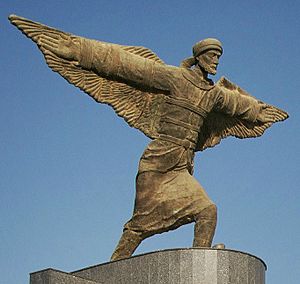Abbas ibn Firnas facts for kids
Quick facts for kids
Abbas ibn Firnas
|
|
|---|---|

Statue of Ibn Firnas outside Baghdad International Airport
|
|
| Born | c. 810 Ronda, Takurunna province, Emirate of Córdoba
|
| Died | 887 Córdoba, Emirate of Córdoba
|
| Known for | Astronomy, engineering, medicine, invention |
Abbas ibn Firnas (born around 810 A.D. – died 887 A.D.) was a brilliant scientist and inventor from Al-Andalus (which is now Spain). He was a polymath, meaning he was skilled in many different areas like astronomy, engineering, chemistry, and even music and poetry. He is most famous for trying to fly!
Ibn Firnas was born in Ronda, a town in what was then the Emirate of Córdoba. He lived most of his life in the city of Córdoba.
Contents
Amazing Inventions and Discoveries
Abbas Ibn Firnas made many important contributions to science and technology.
Glass and Lenses
He figured out how to make clear, colorless glass. This was a big deal because it was hard to make clear glass back then. He also used glass to create special lenses for reading. These were like early magnifying glasses, which helped people read small text more easily.
Astronomy Tools
Ibn Firnas was very interested in the stars and planets. He built a special device that showed how the planets and stars moved in the sky. This was like an early model of our solar system. He also helped bring important astronomical knowledge from India to Europe.
Water Clock
He designed a water clock called "al-Maqata." This clock used water to measure time, which was a clever way to keep track of hours before modern clocks existed.
His Attempt to Fly
One of the most exciting things Abbas ibn Firnas is known for is his attempt to fly. About 700 years after his time, a historian named Ahmad al-Maqqari wrote about it.
The Flight Story
Al-Maqqari wrote that Ibn Firnas covered himself with feathers and attached wings to his body. He then jumped from a high place, hoping to fly. People who saw it said he flew a good distance, like a bird! But when he tried to land, he hurt his back. He didn't know that birds use their tails to land softly, and he hadn't thought to add a tail to his flying device.
An Early Poem
There's an old poem from the 800s that might be about his flight. It says he "flew faster than the phoenix in his flight when he dressed his body in the feathers of a vulture." This poem was written by someone who knew Ibn Firnas, which makes the story even more interesting.
While there's no other detailed record of his flight from his own time, this story has made him famous as one of the first people to try flying.
His Lasting Legacy
Abbas ibn Firnas is remembered as a true pioneer.
- In 1973, a statue of him was placed at the Baghdad International Airport in Iraq.
- In 1976, a crater on the Moon was named "Ibn Firnas" in his honor.
- In 2011, a bridge over the Guadalquivir river in Córdoba, Spain, was named the "Abbas Ibn Firnás Bridge".
- Even an airline was named after him, Firnas Airways.
These honors show how important his work and his spirit of invention were, inspiring people for centuries.
See also
 In Spanish: Abbás Ibn Firnás para niños
In Spanish: Abbás Ibn Firnás para niños
- Hezârfen Ahmed Çelebi
- History of aviation
- Ismail ibn Hammad al-Jawhari
- Lagâri Hasan Çelebi
- List of inventions in the medieval Islamic world
- Timeline of science and technology in the Islamic world

